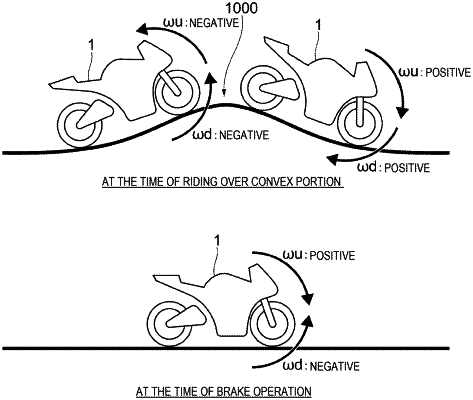| CPC B60G 17/0165 (2013.01) [B62K 25/04 (2013.01); B60G 2300/12 (2013.01); B60G 2400/0522 (2013.01); B60G 2500/11 (2013.01); B60G 2800/014 (2013.01); B62K 2025/044 (2013.01)] | 14 Claims |

|
1. A control device comprising:
a processor configured to control a damping force of a damping device, which damps a force generated between a vehicle body of a two-wheeled vehicle and at least one of a front wheel and a rear wheel, said damping force being calculated based on;
a first angular velocity that is an angular velocity of rotational movement in a front-rear direction of the vehicle body, the first angular velocity being generated due to a difference between a velocity in an up-down direction on a front wheel side of the vehicle body and a velocity in the up-down direction on a rear wheel side of the vehicle body, and
a second angular velocity that is an angular velocity of rotational movement in the front-rear direction of an unsprung part having the front wheel and the rear wheel, the second angular velocity being generated due to a difference between a velocity in the up-down direction of the front wheel and a velocity in the up-down direction of the rear wheel wherein
the processor is configured to control the damping force of the damping device so as to suppress the rotational movement of the vehicle body in a direction of the first angular velocity in a first state where the direction of the first angular velocity and a direction of the second angular velocity are the same, and to make a suppression amount in the direction of the first angular velocity become smaller than a suppression amount of the first state in a second state where the direction of the first angular velocity and the direction of the second angular velocity are different.
|